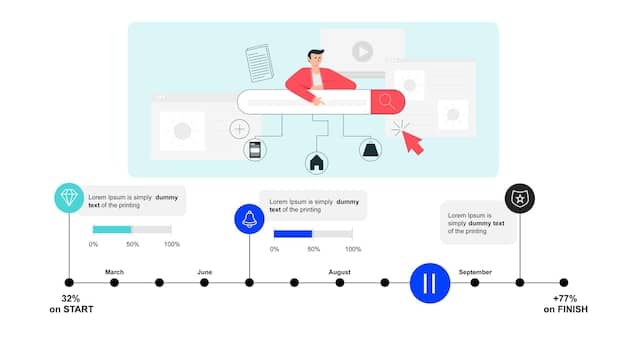Is Your Customer Service Chatbot Costing You Money? Improve CX & Reduce Abandonment

Is Your Customer Service Chatbot Costing You Money? It might be if it’s leading to poor customer experience (CX) and high abandonment rates. Improving chatbot functionality and integration can significantly boost CX and reduce those costly abandonments.
Are you wondering, is your customer service chatbot costing you money? It’s a valid question in today’s digital landscape, where chatbots are increasingly common. While intended to streamline customer interactions and cut costs, a poorly implemented chatbot can actually do the opposite. It can frustrate customers, leading to higher abandonment rates and ultimately, lost revenue.
This article explores five key ways to improve your customer service chatbot, focusing on enhancing customer experience (CX) and reducing abandonment rates to ensure your investment is paying off, not setting you back.
Is Your Customer Service Chatbot Costing You Money? Understanding the Problem
Many businesses implement customer service chatbots with the expectation of improved efficiency and reduced operational costs. However, the reality can be quite different if the chatbot isn’t properly designed and maintained. So, is your customer service chatbot costing you money without you realizing it? Let’s look into the common issues.
Common Chatbot Issues Leading to Customer Frustration
Several factors can contribute to a chatbot’s failure to deliver a positive customer experience. Here are a few potential pitfalls:
- Inability to Understand Complex Queries: Chatbots often struggle with nuanced or complex questions, leading to inaccurate or irrelevant responses.
- Lack of Personalization: Generic responses that don’t address the individual customer’s needs can feel impersonal and frustrating.
- Endless Loops and Dead Ends: When a chatbot can’t resolve an issue, it might lead the customer through a frustrating loop or simply end the conversation without offering a solution.
- Slow Response Times: Customers expect quick answers from chatbots. Delays can lead to impatience and abandonment.
These issues can significantly detract from the customer experience, prompting them to abandon the interaction and potentially seek assistance elsewhere. Ultimately, this can negate the intended cost savings and damage your brand’s reputation.
Recognizing these common pitfalls is the first step towards optimizing your customer service chatbot and ensuring it contributes positively to your bottom line. Addressing these issues head-on can transform your chatbot from a liability into a valuable asset.
5 Ways to Improve CX and Reduce Abandonment Rates with Your Chatbot
Now that we’ve identified the potential problems, let’s explore five actionable strategies to improve your customer service chatbot, enhance customer experience, and reduce abandonment rates. These strategies focus on optimizing chatbot functionality, integrating it seamlessly with other customer service channels, and providing ongoing monitoring and improvement.

1. Enhance Natural Language Processing (NLP)
One of the most critical aspects of a successful customer service chatbot is its ability to understand and respond to natural language. Improving NLP capabilities allows the chatbot to accurately interpret customer queries, even with variations in phrasing and terminology.
- Invest in Advanced NLP Technologies: Implement state-of-the-art NLP algorithms that can handle complex language patterns and contextual nuances.
- Train Your Chatbot on Real Customer Interactions: Use historical chat logs and customer feedback to train your chatbot on common queries and language styles.
- Continuously Monitor and Refine NLP Performance: Regularly assess the chatbot’s accuracy in understanding customer queries and make adjustments as needed.
By enhancing NLP, you can significantly improve the chatbot’s ability to provide relevant and helpful responses, leading to increased customer satisfaction and reduced abandonment rates. This, in turn, helps ensure that is your customer service chatbot costing you money?
2. Personalize the Customer Experience
Generic chatbot interactions can feel impersonal and frustrating for customers. Personalizing the experience based on individual customer data and preferences can significantly improve engagement and satisfaction. Let’s talk more about how you can make sure is your customer service chatbot costing you money.
- Integrate with CRM Systems: Connect your chatbot to your CRM system to access customer data such as purchase history, preferences, and past interactions.
- Use Dynamic Content: Tailor chatbot responses based on customer data, providing personalized greetings, recommendations, and solutions.
- Offer Proactive Assistance: Anticipate customer needs based on their behavior and offer proactive assistance, such as troubleshooting tips or product recommendations.
Personalization makes customers feel valued and understood. This fosters trust, reduces frustration, and increases the likelihood of successful issue resolution. When customers feel heard and understood, they are less likely to abandon the interaction and more likely to remain loyal to your brand.
3. Offer Seamless Escalation to Human Agents
While chatbots can handle many routine queries, there are times when a human agent is necessary to resolve complex or sensitive issues. Providing a seamless escalation process ensures that customers can easily transition to a human agent when needed.
- Implement a Clear Escalation Path: Design a clear and intuitive process for customers to request assistance from a human agent.
- Provide Context to Human Agents: Ensure that human agents have access to the chatbot conversation history, so they can quickly understand the customer’s issue and avoid asking redundant questions.
- Offer Multiple Escalation Options: Provide various escalation options, such as live chat, phone call, or email, to accommodate customer preferences.
By offering a smooth transition to human agents, you can prevent customer frustration and ensure that even the most complex issues are resolved effectively. A good handoff helps ensure that is your customer service chatbot costing you money?
4. Optimize Chatbot Design and User Interface
The design and user interface of your chatbot plays a crucial role in shaping the customer experience. A well-designed chatbot should be intuitive, easy to navigate, and visually appealing.
- Use Clear and Concise Language: Write chatbot responses in plain language that is easy for customers to understand.
- Incorporate Visual Elements: Use images, videos, and other visual elements to enhance engagement and provide additional information.
- Optimize for Mobile Devices: Ensure that your chatbot is fully responsive and optimized for mobile devices, as many customers will be interacting with it on their smartphones.
A user-friendly chatbot design makes it easier for customers to find the information they need and resolve their issues quickly. This leads to increased satisfaction and reduced abandonment rates. Investing in a well-designed chatbot is vital to avoid is your customer service chatbot costing you money.
5. Continuously Monitor and Improve Performance
Improving your customer service chatbot isn’t a one-time task; it requires ongoing monitoring and optimization. Regularly tracking key performance indicators (KPIs) and gathering customer feedback is essential for identifying areas for improvement.
- Track Key Performance Indicators (KPIs): Monitor metrics such as resolution rate, abandonment rate, customer satisfaction, and chatbot usage.
- Gather Customer Feedback: Collect customer feedback through surveys, feedback forms, and social media channels.
- Analyze Data and Identify Trends: Analyze the data you collect to identify patterns and trends that can inform chatbot improvements.
By continuously monitoring and improving performance, you can ensure that your customer service chatbot remains effective and continues to deliver a positive customer experience. This ongoing effort helps avoid the scenario of is your customer service chatbot costing you money in the long run.

Implementing these five strategies can significantly improve your customer service chatbot, leading to enhanced customer experience, reduced abandonment rates, and ultimately, a better return on your investment. By focusing on NLP, personalization, escalation, design, and continuous improvement, you can transform your chatbot from a potential liability into a valuable asset.
| Key Point | Brief Description |
|---|---|
| 💬 NLP Enhancement | Improves chatbot’s understanding, reducing irrelevant responses. |
| 👤 Personalization | Tailors responses using CRM data, enhancing customer feel. |
| 🧑💼 Human Agent Escalation | Ensures smooth transition for complex issues. |
| 📈 Continuous Monitoring | Tracks KPIs to optimize performance over time. |
Frequently Asked Questions
Look at metrics like abandonment rates, customer satisfaction scores, and resolution rates. A high abandonment rate could mean your chatbot isn’t meeting customer needs.
NLP stands for Natural Language Processing. It allows chatbots to understand and respond to human language effectively, leading to more accurate and relevant interactions.
Personalization makes interactions feel more tailored to individual needs, increasing customer satisfaction and loyalty. This is key to ensuring is your customer service chatbot costing you money.
Offer a seamless escalation path to a human agent. This ensures that customers can still receive the help they need without becoming frustrated.
Chatbot performance should be monitored continuously. Updates and improvements should be made regularly based on customer feedback and performance data, otherwise, is your customer service chatbot costing you money?
Conclusion
In conclusion, addressing the question “Is Your Customer Service Chatbot Costing You Money? 5 Ways to Improve CX and Reduce Abandonment Rates” requires a proactive and strategic approach. By focusing on enhancements in NLP, personalization, seamless escalation, optimized design, and continuous monitoring, businesses can transform their chatbots into valuable assets that drive customer satisfaction and reduce costs.
Investing in these improvements will ensure your chatbot delivers a positive ROI, enhancing the customer experience and fostering long-term loyalty. Ultimately these improvements help to ensure that your chatbot is saving you time and money while better serving your existing consumers.





